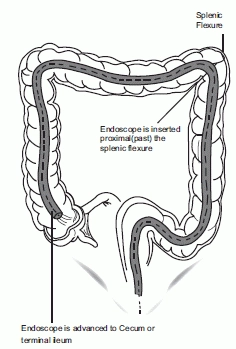Capture the Pay You Deserve With This Roadmap for Lower GI Procedures
New definitions lead the way.
If you’ve ever gotten confused about which type of endoscopy code you should report for a procedure anywhere between the rectum and the terminal ileum, prepare to be to be schooled.
You’ll find a major overhaul of lower gastro-intestinal (GI) procedure codes in CPT® 2015, along with a host of instructional notes to tell you how to use them. Let our experts pull this information together for you in one place so you’ll know where to turn when you encounter lower GI endoscopy cases this year.
Colonoscopy Covers All
If your surgeon advances an endoscope from the rectum to the cecum, that procedure is clearly a colonoscopy (45378-45398, Colonoscopy, flexible…). But a colonoscopy might include even more.
More: According to the CPT® 2015 definition, colonoscopy may also “include examination of the terminal ileum or small intestine proximal to an anastomosis.” That means you shouldn’t get into the small intestine endoscopy codes simply to accommodate the surgeon’s peek at that organ at the end of a colonoscopy.
Less: On the other hand, if the surgeon begins a screening or diagnostic colonoscopy and gets beyond the splenic flexure but can’t proceed to the cecum or colon/small intestine anastomosis as planned, you should still code the procedure as a colonoscopy — just add modifier 53 (Discontinued procedure) to account for the reduced scope. For a therapeutic colonoscopy that meets the same fate, append modifier 52 (Reduced services).
Sigmoidoscopy Stops Here
A sigmoidoscopy (45330-45350, Sigmoidoscopy, flexible…) is more limited than a colonoscopy, involving examination of the entire rectum and sigmoid colon.
More: The CPT® 2015 definition goes on to state that a sigmoidoscopy might include a portion of the descending colon. That means you should not jump to colonoscopy codes if the surgeon also examines the descending colon up to the splenic flexure.
Aborted colonoscopy: If your surgeon preps the patient for a colonoscopy but does not advance the scope beyond the splenic flexure, you should not use a colonoscopy code. “At that point, the procedure matches the sigmoidoscopy definition, and you should select the appropriate sigmoidoscopy code,” says Marcella Bucknam, CPC, CPC-I, CCS-P, CPC-H, CCS, CPC-P, COBGC, CCC, internal audit manager with PeaceHealth in Vancouver, Wash.
Other resections: If the patient has previously undergone a colon resection proximal to the sigmoid colon, such as a subtotal colectomy, and has an anastomosis that is ileo-sigmoid or ileo-rectal, you should use a sigmoidoscopy or proctosigmoidoscopy code instead of a colonoscopy code for a lower GI endoscopic procedure for that patient.
Recognize Stomal Codes
CPT® 2015 creates a new section for colonoscopy through stoma and ileoscopy through stoma.
Stomal ileoscopy: If the surgeon performs an endoscopic exam on a patient who has an ileostomy, report one of the new or revised codes in that section (44380-44384, Ileoscopy through stoma …). For endoscopic evaluation of a small intestinal pouch, select 44385 or 44386 (Endoscopic evaluation of small intestinal pouch (e.g., Kock pouch, ileal reservoir [S or J]…)
Stomal colonoscopy: Report a colonoscopy through stoma (44388-44408, Colonoscopy through stoma …) for an endoscope inserted through the stoma and advanced to the anastomosis between the colon and small intestine, or to the cecum (including terminal ileum or small intestine proximal to an anastomosis, if performed).
What if the patient had a prior colon resection that leaves him with a colostomy and without a complete colon from rectum to cecum? For instance, the patient may have undergone a hemicolectomy, a sigmoid colectomy, or a low anterior resection, thus limiting the length or colon examined with an endoscope. “In these cases, CPT® 2015 instruction directs you to use the colonoscopy through stoma codes,” Bucknam says.
Two procedures: Sometimes a patient may require both a sigmoidoscopy and a colonoscopy through stoma during the same session. This can happen when the patient has had a prior surgery that required a temporary colostomy, for instance.
“In many cases, the colostomy was performed emergently for acute diverticulitis or because of an obstructing cancer. The entire colon was not examined either before surgery or immediately afterward, so before repairing the colon, the surgeon will often require a thorough examination of the colon above the colostomy opening and then for the distal colon from the anus up to the diversion,” explains Michael Weinstein, MD, former representative of the AMA’s CPT® Advisory Panel.
In this instance, you can safely report codes 44388 (Colonoscopy through stoma; diagnostic, including collection of specimen[s] by brushing or washing, when performed [separate procedure]) and 45330 (Sigmoidoscopy, flexible; diagnostic, including collection of specimen[s] by brushing or washing, when performed [separate procedure]).
Proctosigmoidoscopy Focuses on Rectum
When the surgeon endoscopically examines the rectum and possibly a portion of the sigmoid colon, you should use the proctosigmoidoscopy codes (45300-45327 (Proctosigmoidoscopy, rigid ...).
CPT® 2015 doesn’t revise or add any new proctosigmoidoscopy codes, but the instructions add the definition to help you distinguish the scope of these services compared to other lower GI endoscopy codes.





